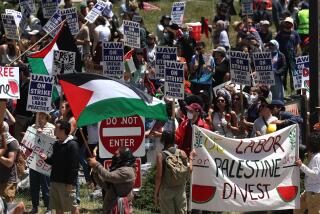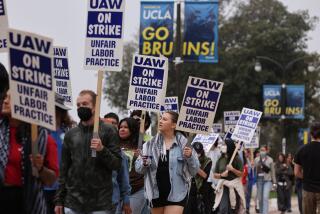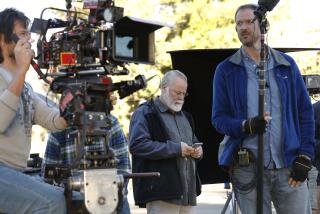L.A. Strike Ends After 2 Days
- Share via
The Engineers and Architects Assn. concluded a two-day strike Wednesday, pulling down picket lines after failing to seriously disrupt public services or force Los Angeles city officials to offer a better raise to the union’s more than 7,500 workers.
“It’ll end tonight,” Robert Aquino, the union’s executive director, said Wednesday afternoon outside City Hall.
The marching and protests, while gaining few tangible results for the union, appeared conversely to bolster the political fortunes of its chief adversary, Mayor Antonio Villaraigosa.
Over the two days, Villaraigosa stood fast on the city’s contract offer and shrugged off union charges that he was a “scab” for crossing the picket line. The mayor’s stand meant that the former union organizer defied a labor group that supported him and contributed to his campaign in 2005.
Villaraigosa welcomed the striking employees back to work and said he would tolerate no retaliation against them. At a news conference earlier in the day, he downplayed the strike’s impact on the city. “There has not been a massive job action here, let’s be clear about that,” he said.
The strike had originally been scheduled to last two days, although union officials had previously said they might extend it beyond Wednesday.
The walkout did not appear to meet the expectations of many union members. Before the walkout, the union’s radio ads suggested that a strike would cause the closure of airport runways, the release of sewage into Santa Monica Bay and citywide gridlock, none of which happened.
The strike also did not move city officials from the salary terms they unilaterally imposed on union members last week: a 6.25% raise over three years, from July 2004 through June 2007. The union’s members, who include city accountants, forensic scientists and other technical and professional employees, have been working without a contract since 2004.
Nevertheless, Aquino said the strike was a success because it had some effect on city operations and drew the support of Teamsters, longshoremen and teachers, and attracted attention for the previously obscure EAA union. “The only story bigger than you guys is the JonBenet case,” he told workers on a picket line.
Aquino also threatened future job actions, including strikes, if the city failed to return to the negotiating table in the days ahead. He pointedly told striking workers to leave their signs with picket captains -- in case they were needed again soon. “We’ll keep them in storage in case the city didn’t listen,” Aquino said.
The union said that of 4,500 workers who failed to show up for work, 2,000 had joined picket lines in front of 30 city offices. But City Administrative Officer Bill Fujioka said that as of Wednesday morning, only 649 workers were on picket lines and more than 2,000 were absent from work. At the same time Tuesday, the city had counted 861 pickets, according to General Services Department public safety officers.
Even striking workers said they did not see the same number of people Wednesday as on Tuesday. Kevin Davis, 41, a lifeguard supervisor who picketed outside city offices in Van Nuys, said the turnout was down by as much as half, but he believed the walkout was worthwhile.
“I don’t think it’s going to make the mayor run down to the office tomorrow and offer us more money, but since we’re coming up on new contract negotiations for next year, I think what this will do is tell the mayor, ‘Hey, don’t brush us aside, take us more seriously, because we have value too,’ ” Davis said.
Ed Wilson, who was leading workers picketing at the Department of Building and Safety offices on Figueroa Street, said: “Maybe people went to the beach.”
“I don’t think the city is going to come back to the table because we haven’t hurt them hard,” Wilson said. He expressed optimism that the first strike in the union’s 112-year history had made many members more active. “Perhaps the next time we have a job action, it will have more of a sting.”
Villaraigosa acknowledged that city operations had been affected by the strike. At Los Angeles International Airport, work on a crucial project to move the airport’s southernmost runway slowed for a second day as members of the Teamsters and another union refused to cross an EAA picket line. Only about 60 workers out of an estimated 100 to 125 workers on the project showed up for work Wednesday, said Paul Haney of the city’s airport agency.
City Councilman Tom LaBonge said seven city swimming pools were closed because workers had joined the strike. (The union said all 59 pools were closed.) Outside the gates of the huge Hyperion sewage treatment plant south of LAX, striking union members maintained picket lines for a second day. Kay Yamamoto, a water biologist for the city, said most of the workers who take water quality samples at Santa Monica Bay beaches were off the job again Wednesday. “For the past two days, it’s highly questionable whether they were able to protect the public’s health,” Yamamoto said.
But whatever the impact, the strike appeared to leave the engineers and architects union isolated not only from the city’s political elite, but from other powerful union leaders who represent public workers.
Before and during the strike, Aquino as well as rank-and-file members criticized other city employees who showed up for work. “There are some who just don’t get it,” Aquino said. On Tuesday, he said that he had not asked the Los Angeles County Federation of Labor for an official strike sanction because “the mayor has a lot of control over the labor federation.”
That drew a retort from the federation’s head, Maria Elena Durazo: “No one has control over the L.A. federation. We have a very democratic internal process for our union affiliates to discuss strike sanction.”
On Wednesday, the EAA issued a news release accusing members of International Brotherhood of Electrical Workers Local 18, which represents Department of Water and Power workers, of being scabs. IBEW received raises in its most recent contract that are the envy of other unions.
Brian D’Arcy, business manager of IBEW Local 18, said it was unfair to criticize members of a union with a signed contract. Asked what the EAA strike had accomplished, D’Arcy said: “I don’t think it helps anybody if there’s no end game involved. Quite frankly, I don’t understand the strategy.”
Officials with the city and in the labor movement suggested the strike could be a prologue to a larger battle between Villaraigosa and other city worker unions when their contracts expire next summer. Those unions have already begun preparations for a possible strike.
“I think this is not the main event,” said Raphael Sonenshein, a political science professor at Cal State Fullerton and author of “The City at Stake: Secession, Reform, and the Battle for Los Angeles.” “The main event is next year. I think it’s deceptive how easy this was for the city.”
The strike was peaceful, with no reports of arrests, according to police and the union. Internal affairs officers at the Los Angeles Police Department continue to investigate a complaint that an officer shoved striking workers as they picketed outside Piper Tech, just east of Union Station, on Tuesday morning.
City officials also said they would go to court Friday to pursue legal sanctions against as many as 43 workers who did not show up for work even though they were enjoined by a Superior Court judge on Monday from striking. They were among 200 workers legally barred from striking because they served in critical positions in airports, sewage plants or emergency services.
Aquino called the mayor “petulant” for seeking such action, and said workers had not received written notice that they were prevented from striking.
Times staff writers Steve Hymon, Jim Newton, Jeff Rabin, Stuart Silverstein and Nancy Wride contributed to this report.
More to Read
Sign up for Essential California
The most important California stories and recommendations in your inbox every morning.
You may occasionally receive promotional content from the Los Angeles Times.









